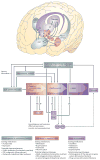Development of pharmacotherapies for drug addiction: a Rosetta stone approach
- PMID: 19483710
- PMCID: PMC2760328
- DOI: 10.1038/nrd2828
Development of pharmacotherapies for drug addiction: a Rosetta stone approach
Abstract
Current pharmacotherapies for addiction represent opportunities for facilitating treatment and are forming a foundation for evaluating new medications. Furthermore, validated animal models of addiction and a surge in understanding of neurocircuitry and neuropharmacological mechanisms involved in the development and maintenance of addiction - such as the neuroadaptive changes that account for the transition to dependence and the vulnerability to relapse - have provided numerous potential therapeutic targets. Here, we emphasize a 'Rosetta Stone approach', whereby existing pharmacotherapies for addiction are used to validate and improve animal and human laboratory models to identify viable new treatment candidates. This approach will promote translational research and provide a heuristic framework for developing efficient and effective pharmacotherapies for addiction.
Conflict of interest statement
Figures


Similar articles
-
Existing and Future Drugs for the Treatment of the Dark Side of Addiction.Annu Rev Pharmacol Toxicol. 2016;56:299-322. doi: 10.1146/annurev-pharmtox-010715-103143. Epub 2015 Oct 22. Annu Rev Pharmacol Toxicol. 2016. PMID: 26514207 Review.
-
Preclinical Medication Development: New Targets and New Drugs.Alcohol Clin Exp Res. 2016 Jul;40(7):1418-24. doi: 10.1111/acer.13105. Epub 2016 May 14. Alcohol Clin Exp Res. 2016. PMID: 27177689 Free PMC article. Review. No abstract available.
-
Model-based drug discovery: implementation and impact.Drug Discov Today. 2013 Aug;18(15-16):764-75. doi: 10.1016/j.drudis.2013.05.012. Epub 2013 May 29. Drug Discov Today. 2013. PMID: 23726890 Review.
-
Replicated, replicable and relevant-target engagement and pharmacological experimentation in the 21st century.Biochem Pharmacol. 2014 Jan 1;87(1):64-77. doi: 10.1016/j.bcp.2013.10.024. Epub 2013 Nov 19. Biochem Pharmacol. 2014. PMID: 24269285 Review.
-
From fragment to clinical candidate--a historical perspective.Drug Discov Today. 2009 Jul;14(13-14):668-75. doi: 10.1016/j.drudis.2009.04.007. Epub 2009 May 7. Drug Discov Today. 2009. PMID: 19427404 Review.
Cited by
-
Experimental psychiatric illness and drug abuse models: from human to animal, an overview.Methods Mol Biol. 2012;829:31-48. doi: 10.1007/978-1-61779-458-2_2. Methods Mol Biol. 2012. PMID: 22231805 Free PMC article. Review.
-
A mechanistic overview of approaches for the treatment of psychostimulant dependence.Front Pharmacol. 2022 Sep 8;13:854176. doi: 10.3389/fphar.2022.854176. eCollection 2022. Front Pharmacol. 2022. PMID: 36160447 Free PMC article. Review.
-
The PPARγ Agonist Pioglitazone Fails to Alter the Abuse Potential of Heroin, But Does Reduce Heroin Craving and Anxiety.J Psychoactive Drugs. 2018 Nov-Dec;50(5):390-401. doi: 10.1080/02791072.2018.1508789. Epub 2018 Sep 11. J Psychoactive Drugs. 2018. PMID: 30204554 Free PMC article. Clinical Trial.
-
Naltrexone alters alcohol self-administration behaviors and hypothalamic-pituitary-adrenal axis activity in a sex-dependent manner in rats.Pharmacol Biochem Behav. 2018 Apr;167:50-59. doi: 10.1016/j.pbb.2018.02.003. Epub 2018 Feb 24. Pharmacol Biochem Behav. 2018. PMID: 29486222 Free PMC article.
-
An efficient early phase 2 procedure to screen medications for efficacy in smoking cessation.Psychopharmacology (Berl). 2014 Jan;231(1):1-11. doi: 10.1007/s00213-013-3364-6. Epub 2013 Dec 3. Psychopharmacology (Berl). 2014. PMID: 24297304 Free PMC article. Review.
References
-
- Koob GF, Le Moal M. Drug abuse: hedonic homeostatic dysregulation. Science. 1997;278:52–58. - PubMed
-
- Kreek MJ, LaForge KS, Butelman E. Pharmacotherapy of addictions. Nature Rev Drug Discov. 2002;1:710–726. erratum 1, 926 (2002) - PubMed
-
- Deroche-Gamonet V, Belin D, Piazza PV. Evidence for addiction-like behavior in the rat. Science. 2004;305:1014–1017. - PubMed
-
- Vanderschuren LJ, Everitt BJ. Drug seeking becomes compulsive after prolonged cocaine self-administration. Science. 2004;305:1017–1019. - PubMed
-
-
Heinz A, Beck A, Grüsser SM, Grace AA, Wrase J. Identifying the neural circuitry of alcohol craving and relapse vulnerability. Addict Biol. 2009;14:108–118.. This study showed a positive correlation between functional brain activation elicited by alcohol-related cues and risk of relapse, suggesting a novel imaging approach in humans.
-
Publication types
MeSH terms
Substances
Grants and funding
- DA10072/DA/NIDA NIH HHS/United States
- DK26741/DK/NIDDK NIH HHS/United States
- DA04398/DA/NIDA NIH HHS/United States
- P20 DA024194/DA/NIDA NIH HHS/United States
- AA08459/AA/NIAAA NIH HHS/United States
- R01 AA012602/AA/NIAAA NIH HHS/United States
- R01 AA008459/AA/NIAAA NIH HHS/United States
- P01 DK026741/DK/NIDDK NIH HHS/United States
- P60 AA006420/AA/NIAAA NIH HHS/United States
- DA04043/DA/NIDA NIH HHS/United States
- R01 DA004043/DA/NIDA NIH HHS/United States
- R01 DA004398/DA/NIDA NIH HHS/United States
- P50 AA006420/AA/NIAAA NIH HHS/United States
- AA06420/AA/NIAAA NIH HHS/United States
- AA12602/AA/NIAAA NIH HHS/United States
- R01 AA014028/AA/NIAAA NIH HHS/United States
- R01 DA010072/DA/NIDA NIH HHS/United States
- R37 AA014028/AA/NIAAA NIH HHS/United States
- R37 AA008459/AA/NIAAA NIH HHS/United States
LinkOut - more resources
Full Text Sources
Other Literature Sources
Medical

